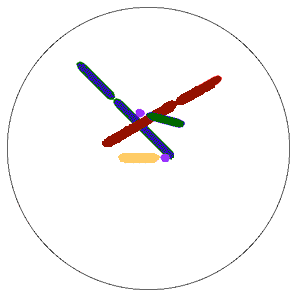Mapping Grandchildren's Chromosomes to their Grandparents:
A Case Study of Genetic Recombination
The graphics below are chromosome maps of shared DNA between two full sisters, Cathryn and Isabelle, and all four of their grandparents. All four grandparents and the granddaughters tested at Family Tree DNA. The shared DNA segment data for each grandparent/grandchild was downloaded from the FTDNA chromosome browser. It was then uploaded to http://kittymunson.com/dna/ChromosomeMapper.php where each girl's chromosomes were mapped to show which segments she got from each grandparent. Each longitudinal bar in the diagram represents a chromosome pair (so basically two strands of DNA, one from their mother and one from their father). Segments from their paternal grandparents are represented on the top bar of each chromosome—the paternal grandmother in dark blue and the paternal grandfather in light blue. The bottom bar represents the maternal chromosomes, red from the maternal grandmother and orange from the maternal grandfather. You can see the chromosomes are a patchwork of segments from each of the four grandparents! Also notice that each girl's map shows a different mix of segments from all four grandparents. It is like shuffling and drawing cards. There is a different mix each time.
Without question, we each get a 50/50 split of DNA from our parents. Family Tree DNA reports the total amount of DNA shared between a parent and child to be 3384 cM over 22 segments. The 23rd chromosomes (X & Y) are not included in the shared DNA amount reports. However, they are included in the chromosome browser maps. Click here to see a parent child chromosome map. Click again to close.
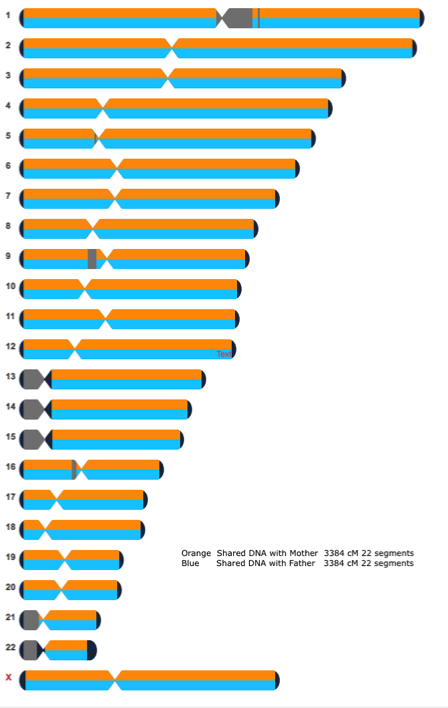
Cathryn
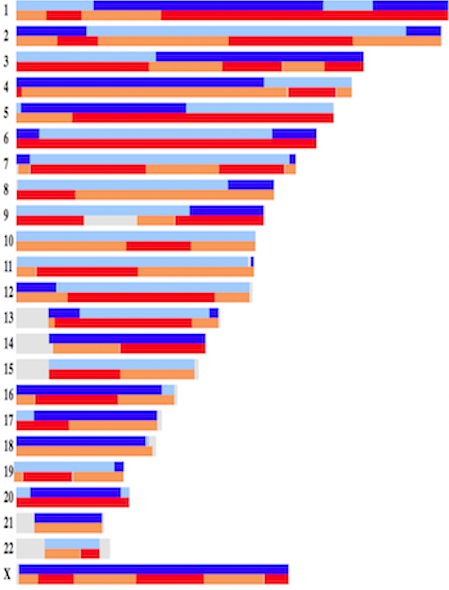

Isabelle
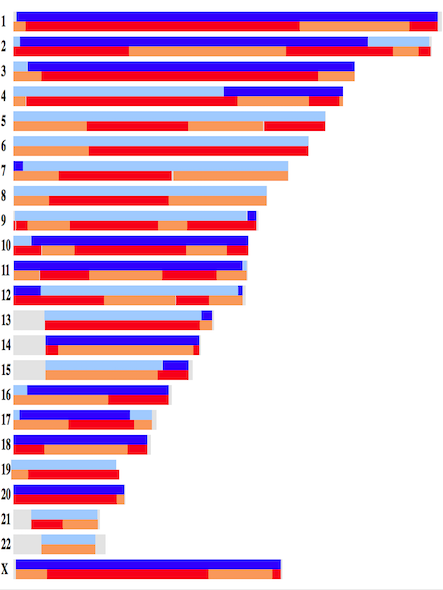

"Family Finder," database, FamilyTreeDNA (http://www.FamilyTreeDNA.com : downloaded 24 May 2017), using the "Matches" and "Chromosome Browser" options to query for [Private female 1 and Private female 2 and their grandparents]; results from this dynamic database require the private passcode and kit number of these individuals.
Chromosome Mapping Tool by Kitty Cooper at
http://kittymunson.com/dna/ChromosomeMapper.php
Grayed chromosome segments are SNP poor regions that are not tested by Family Tree DNA Family Finder.
Cathryn


Isabelle
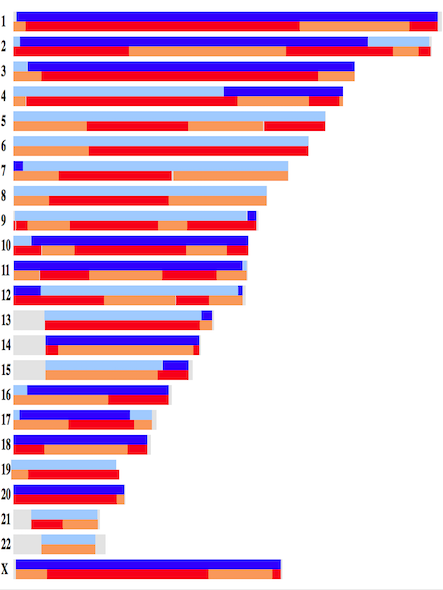

"Family Finder," database, FamilyTreeDNA (http://www.FamilyTreeDNA.com : downloaded 24 May 2017), using the "Matches" and "Chromosome Browser" options to query for [Private female 1 and Private female 2 and their grandparents]; results from this dynamic database require the private passcode and kit number of these individuals.
Chromosome Mapping Tool by Kitty Cooper at
http://kittymunson.com/dna/ChromosomeMapper.php
Grayed chromosome segments are SNP poor regions that are not tested by Family Tree DNA Family Finder
We might expect each granddaughter to share half of each parent's DNA or 1682 cM with each grandparent. However, with all the mixing and shuffling of recombination and meiosis, we are not guaranteed a straight 25/25/25/25 split from four grandparents. Cathryn received the highest percentage of her DNA from her paternal grandfather—1927 cM, about 28%. Only about 22% of her DNA came from her paternal grandmother. Together the paternal grandparents' contribution is 50% of Cathryn's DNA but it is not evenly divided between them because of the cross-over and random shuffling that happened when the sperm was formed.
The split between Cathryn's maternal grandparents was more balanced—26% from her maternal grandmother and 24% from her maternal Grandfather.
On the right (or beneath, if you are viewing on a mobile phone screen) is Cathryn's full sister Isabelle's chromosome map. Though they share the same parents and thus the same four grandparents, they each received a different genetic mix. Isabelle received an almost even 25/25% mix from her paternal grandparents but the maternal grandparents' contributions were less balanced. Isabelle's largest grandparent contribution came from her maternal grandmother who shares 1919 cM or about 28% with her. This leaves a 22% share for Isabelle and her maternal grandfather. Isabelle has a 25/25/28/22 (paternal grandfather/paternal grandmother/maternal grandmother/maternal grandfather) split to account for the sources of her DNA compared to her sister Cathryn's split of 28/22/26/24 respectively from the same set of grandparents.
Cathryn and Issabelle's maternal X chromosomes are not identical. Each is a unique patchwork of red and orange from both maternal grandparents spliced together during the processes of recombination and meiosis. On the other hand, the girls share an identical X chromosome (dark blue) received from their father. Their father received that chromosome from his mother and passed it on to his daughters intact as there is no crossover between the X and Y chromosomes. It is an exact match to their paternal grandmother's X chromosome. All sisters who share a father share one identical X chromosome (196 cM of DNA) received from him. This can be very helpful in determining which parent is shared between two half sisters who do not know their origins.

